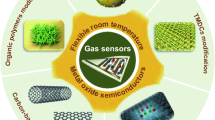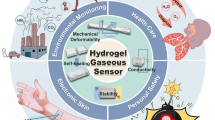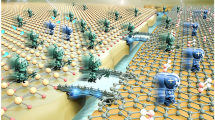Abstract
The paper investigates the electrical properties of the junction between the graphene oxide (GO) and some metals (Cu and Au). A simple humidity sensor, based on the adsorption of water molecules on the GO/surface in a GO/Cu junction, is described. The GO was drop-casted as a thin film, 10 μm in thickness, on the metallic substrate. The junction open-circuit voltage and short-circuit current behaviours versus the humidity level can be explained on the base of the charge carrier drift. The room temperature response of the GO/Cu water vapour detector, in terms of relative humidity in air, is compared against a well-known commercial hygrometer. The proposed device does not require external polarization, and it is inexpensive and easy to use.








Similar content being viewed by others
References
A.T. Dideikin, A.Y. Vul', Graphene oxide and derivatives: the place in graphene family. Front. Phys. 6(149), 1 (2019)
L. Torrisi, L. Silipigni, M. Cutroneo, A. Torrisi, Graphene oxide as a radiation sensitive material for XPS dosimetry. Vacuum 173, 109175 (2020)
M. Aliofkhazraei, N. Ali, W.I. Milne, C.S. Ozkan, S. Mitura, J.L. Gervasoni, Science Handbook, Mechanical and Chemical Properties (CRC Press Taylor & Francis Group, Boca Raton, 2016)
H. Bi, K. Yin, X. Xie, J. Ji, S. Wan, L. Sun, M. Terrones, M.S. Dresselhaus, Ultrahigh humidity sensitivity ofgraphene oxide. Sci. Rep. 3(2714), 1 (2013)
M. Aliofkhazraei, N. Ali, W.I. Milne, C.S. Ozkan, S. Mitura, J.L. Gervasoni, Science Handbook, Electrical and optical Properties (CRC Press Taylor & Francis Group, Boca Raton, 2016)
L. Silipigni, G. Salvato, G. Di Marco, B. Fazio, A. Torrisi, M. Cutroneo, L. Torrisi, Band-like transport in high vacuum thermal reduced graphene oxide films. Vacuum 165, 254 (2019)
M. Chen, F. Soyekwo, Q. Zhang, C. Hu, A. Zhu, Q. Liu, Graphene oxide nanosheets to improve permeability and selectivity of PIM-1 membrane for carbon dioxide separation. J. Ind. Eng. Chem 63, 296 (2018)
L. Silipigni, G. Salvato, B. Fazio, G. Di Marco, E. Proverbio, M. Cutroneo, A. Torrisi, L. Torrisi, Temperature sensor based on IR-laser reduced graphene oxide. JINST 15(04), C04006 (2020)
H. Huang, S. Su, N. Wu, H. Wan, S. Wan, H. Bi, L. Sun, Graphene-based sensors for human health monitoring. Front. Chem. 7(399), 1 (2019)
Y. Yao, X. Chen, H. Guo, Z. Wu, X. Li, Humidity sensing behaviors of graphene oxide-silicon bi-layer flexible structure. Sens. Actuators B 161, 1053 (2012)
L. Torrisi, L. Silipigni, M. Cutroneo, Radiation effects of IR laser on graphene oxide irradiated in vacuum and in air. Vacuum 153, 122 (2018)
C.K. Chua, M. Pumera, Chemical reduction of graphene oxide: a synthetic chemistry viewpoint. Chem. Soc. Rev. 43, 291 (2014)
L. Torrisi, M. Cutroneo, A. Torrisi, G. Salvato, E. Proverbioand, L. Silipigni, Reduction of graphene oxide foils by IR laser irradiation in air. JINST 15(1), C03006 (2020)
T. Cusati, G. Fiori, A. Gahoi, V. Passi, M.C. Lemme, A. Fortunelli, G. Iannaccone, Electrical properties of graphene-metal contacts. Sci. Rep. 7(5109), 1 (2017)
S. Gupta, J. Narayan, Reduced graphene oxide/amorphous carbon P−N junctions: nanosecond laser patterning. ACS Appl. Mater. Interfaces 11, 24318 (2019)
K. Naito, N. Yoshinaga, S. Matake, Y. Akasaka, Work-function decrease of transparent conducting films composed of hydrazine-reduced graphene oxide and silver nanowire stacked layers by electrochemical treatment. Synth. Met. 195, 260 (2014)
L. Torrisi, M. Cutroneo, A. Torrisi, L. Silipigni, V. Havranek, Small-field dosimetry based on reduced graphene oxide under MeV helium beam irradiation. Rad. Eff. Defects Solids 175(1–2), 120 (2020)
X. Wang, Y. Zhao, E. Tian, J. Li, Y. Ren, Graphene oxide-based polymeric membranes for water treatment. Adv. Mater. Interfaces 5(15), 1 (2018)
D. Sun, Y. Luo, M. Debliquy, C. Zhang, Graphene-enhanced metal oxide gas sensors at room temperature: a review. Beilstein J. Nanotechnol. 9, 2832 (2018)
N. Wei, X. Peng, Z. Xu, Understanding water permeation in graphene oxide membranes. ACS Appl. Mater. Interfaces 6, 5877 (2014)
D.T. Phan, G.S. Chungn, P–n junction characteristics of graphene oxide and reduced graphene oxide on n-type Si(111). J. Phys. Chem. Solids 74, 1509 (2013)
T.E. Timofeeva, Z.I. Evseev, P.V. Vinokurov, G.N. Alexandrov, S.A. Smagulova, The effect of temperature conditions during graphene oxide synthesis on humidity dependence of conductivity in thermally reduced graphene oxide. J. Struct. Chem. 59(4), 799 (2018)
Q. Fatima, A.A. Haidry, Z. Yao, Y. He, Z. Li, L. Sun, L. Xie, The critical role of hydroxyl groups in water vapor sensing of graphene oxide. Nanoscale Adv. 1, 1319 (2019)
N. Agmon, The Grotthuss mechanism. Chem. Phys. Lett. 244, 456 (1955)
I.A. Kotin IV, O.M.O. Antonova, S.A. Smagulova, Origin of hole and electron traps in graphene oxide. Mater. Res. Express 3, 066301 (2016)
Graphenea, High quality Graphene producer, actual website (2020), https://www.graphenea.com/collections/graphene-oxide
L. Torrisi, M. Cutroneo, V. Havranek, L. Silipign, B. Fazio, M. Fazio, G. Di Marco, A. Stassi, A. Torrisi, Self-supporting graphene oxide films preparation and characterization methods. Vacuum 160, 1 (2019)
AM2302 Hygrometer, actual website (2020), https://www.kandrsmith.org/RJS/Misc/Hygrometers/calib_dht22.html#references
AM2302, Hygrometer, technical characteristics, actual website (2020), https://cdn-shop.adafruit.com/datasheets/Digital+humidity+and+temperature+sensor+AM2302.pdf
S. Halas, T. Durakiewicz, Work functions of elements expressed in terms of the Fermi energy and the density of free electrons. J. Phys. 10, 10815 (1998)
L. Sygellou, G. Paterakis, C. Galiotis, D. Tasis, Work function tuning of reduced graphene oxide thin films. J. Phys. Chem. C 120(1), 281 (2016)
J. Liu, M. Durstock, L. Dai, Graphene oxide derivatives as hole- and electron extraction layers for high-performance polymersolar cells. Energy Environ. Sci. 7, 1297 (2014)
T. Kullmann, I. Barta, B. Antus, M. Valyon, I. Horva, Environmental temperature and relative humidity influence exhaled breath condensate pH. Eur. Respir. J. 31(2), 474 (2008)
S. Borini, R. White, D. Wei, M. Astley, S. Haque, E. Spigone, N. Harris, J. Kivioja, T. Ryhanen, Ultrafast graphene oxide humidity sensors. ACS Nano 7(12), 11166 (2013)
Acknowledgements
The authors thank the INFN-CIMA project in which the research was developed.
Author information
Authors and Affiliations
Corresponding author
Additional information
Publisher's Note
Springer Nature remains neutral with regard to jurisdictional claims in published maps and institutional affiliations.
Rights and permissions
About this article
Cite this article
Torrisi, L., Silipigni, L. & Salvato, G. Graphene oxide/Cu junction as relative humidity sensor. J Mater Sci: Mater Electron 31, 11001–11009 (2020). https://doi.org/10.1007/s10854-020-03648-5
Received:
Accepted:
Published:
Issue Date:
DOI: https://doi.org/10.1007/s10854-020-03648-5




